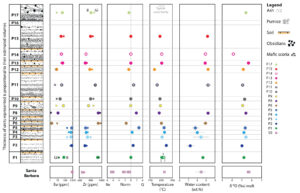Ellis, B.S.; Pimentel, A.; Wolff, J.A.; Etter, A.; Cortes-Calderon, E.A.; Harris, C.; Mark, D.F.; Neukampf, J.; Bachmann, O.
Journal of Volcanology and Geothermal Research, 2022, 107673

Voir en ligne : https://doi.org/10.1016/j.jvolgeores.2022.107673
Abstract :
Many volcanoes have the ability to impact human infrastructure with explosive activity and understanding the processes of magma generation and conditions of storage in these systems remains a priority. The Sete Cidades volcano on the island of São Miguel, Azores archipelago is exactly such a volcano lying only 12 km from the island’s capital city of Ponta Delgada and has been repeatedly active during the Holocene. Sete Cidades is the westernmost central volcano of São Miguel and its most recent explosive volcanism produced the Pepom series of 17 trachytic pumice deposits that were erupted from vents within the caldera. These variably magmatic and phreatomagmatic eruptions involved trachytic magmas that represent the end point of a magmatic evolution dominated by crystal fractionation processes. The magmas contain a mineral assemblage dominated by feldspar, with biotite, clinopyroxene, Fe Ti oxides, amphibole, and trace apatite. Mineral thermometry and hygrometry reveal that the Pepom magmas were stored at temperatures of 789 ± 23 °C to 894 ± 20 °C under volatile-rich conditions (mostly >5 wt% water). Intercalated within the trachytic pyroclastic succession are mafic products that were erupted from vents on the flanks of the volcano suggesting that the evolved, shallow magmatic system may be acting as a barrier to ascending mafic magmas. The Pepom tephra deposits represent trachytic magmas that show limited evidence for the involvement of feldspar-dominated cumulates as has been observed in other settings whereas the preceding, caldera-forming, Santa Bárbara eruption suggests such involvement. Despite the predominant role of fractionation in petrogenesis, the Pepom tephras formed from mildly low-δ18O magmas (4.1 to 5.6‰ for trachyte) and as such require the addition of hydrothermally altered material. The cause of the low-δ18O values remains unknown, but low-δ18O, hydrothermally altered syenitic clasts found within deposits from the nearby Fogo volcano may be potentially analogues.
Ti oxides, amphibole, and trace apatite. Mineral thermometry and hygrometry reveal that the Pepom magmas were stored at temperatures of 789 ± 23 °C to 894 ± 20 °C under volatile-rich conditions (mostly >5 wt% water). Intercalated within the trachytic pyroclastic succession are mafic products that were erupted from vents on the flanks of the volcano suggesting that the evolved, shallow magmatic system may be acting as a barrier to ascending mafic magmas. The Pepom tephra deposits represent trachytic magmas that show limited evidence for the involvement of feldspar-dominated cumulates as has been observed in other settings whereas the preceding, caldera-forming, Santa Bárbara eruption suggests such involvement. Despite the predominant role of fractionation in petrogenesis, the Pepom tephras formed from mildly low-δ18O magmas (4.1 to 5.6‰ for trachyte) and as such require the addition of hydrothermally altered material. The cause of the low-δ18O values remains unknown, but low-δ18O, hydrothermally altered syenitic clasts found within deposits from the nearby Fogo volcano may be potentially analogues.



